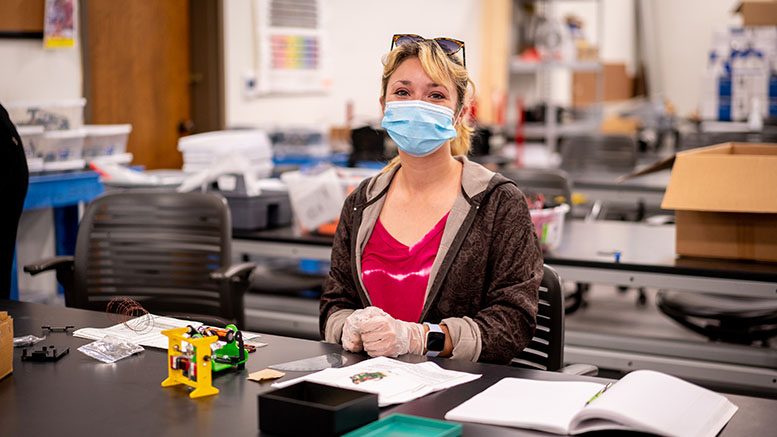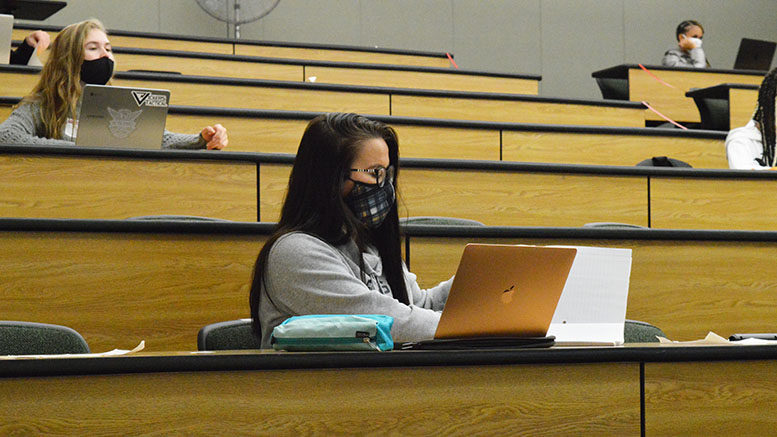A growing number of community colleges are optimistic when it comes to having more students on campus this fall. Yet even those colleges have degrees of comfort. Some already are setting flexible target goals for the number of students they think they can serve on campuses, while others will wait until the end of the spring term to plan ahead.
Editor’s note: This is the second of two articles examining various approaches community colleges are taking to more in-person, on-campus learning this fall. Read the first article.
In Michigan, Jackson College has nearly all classes online except for a few that are “incredibly hard to replicate online,” said President Dan Phelan. But the college is cautiously permitting more in-person learning and plans for half of its students to return to campus this fall.
Like at most community colleges, in-person classes at Jackson College include lab-based classes in the hard sciences and some classes in nursing and allied health, which Phelan said are “prioritized to be able to get graduates into the workplace and help with Covid.” Nursing labs, clinicals and some lectures take place on campus, and other parts of the class are taught remotely.
With those exceptions, classes this semester are taught either full online, on the student’s own schedule within the semester dates, or synchronously, with classes meeting remotely at the scheduled class time.
“We tell students, ‘If you like structure, synchronous is for you,’” Phelan said. “‘If you have three part-time jobs, you may want asynchronous, where you can do the work on your own schedule.’”
The spring and summer semesters will offer more in-person classes. The college is encouraging first-generation and at-risk students to take in-person classes.
Changes to semester schedule
Starting a year ago, Jackson College changed its semester schedule to offer two compressed, seven-week terms each semester instead of one 15-week term. There are also five- and ten-week options.
“We’re trying to position ourselves to be a year-round college,” Phelan said.
Everyone who comes on campus must fill out a questionnaire and go through a testing center with a temperature check. They must wear a mask at all times except when eating and must stay physically distanced from others.
Classrooms have had to be reconfigured. A classroom that would normally hold 35 students now holds 10 to 15. In some cases, walls between classrooms are broken down so one can be twice as big and still hold the same number of students. Sound amplification and media magnification are added.
“We’re burning through a lot of cash,” Phelan said.
‘A dimmer switch’
As inoculation levels increase, Phelan anticipates about 50% of classes will be in person in the fall.
“It’s not flipping the light switch on,” Phelan said. “It’s more of a dimmer switch, increasing the light intensity as we move toward the fall semester.”
But “we’re months and months and months away from a high vaccination level,” he added.
The college will still have an online presence in the fall. But obstacles remain. Some students don’t have good internet access. The college has acquired wi-fi hotspots and is looking at providing more laptops for students.
Like most community colleges, Jackson has seen a drop in enrollment during the pandemic, ranging from 13% last fall to 9% in the current semester.
Depending on vaccinations
At Ventura County Community College District (VCCCD) in California, 10% of classes are in person now, and its three colleges are aiming for at least 50% in the fall, said Chancellor Greg Gillespie. But predictions are hard.
“Our pandemic level is at its highest,” Gillespie said in early February.
VCCCD has put a premium on offering in-person instruction for labs or other classes that require onsite skill development, such as auto mechanics. Summer classes will be all online. They were already over 50% online before the pandemic.
“I’m hopeful with vaccine availability,” Gillespie said.
Ventura County is in Phase 1 for vaccines, offering shots to those 75 and older and to essential workers. Those working in education are in the next tier. Gillespie hopes VCCCD staff will have access to the vaccine by late spring or early summer.
“We’d like our employees to be vaccinated to be back on campus,” he said. “We haven’t mandated it. We’re working with our two unions to communicate that to employees.
“We recognize it’s probably unlikely we’ll have all the students vaccinated by August,” he said. “That’s going to impact our ability to offer in-person classes.”
Being ready
Currently, anyone coming to campus must submit a pre-screening form, report symptoms, get a temperature check, wear a mask and sometimes a face shield.
“It’s quite intensive,” Gillespie said. He expects the screening requirements will still be needed in the fall.

“Between now and April 19, when fall registration begins, our colleges are looking at how best to increase onsite, face-to-face instruction. From April to August, they can adjust any onsite classes to online if infections increase.”
VCCCD has seen a 7% enrollment drop since before the pandemic, Gillespie said. Some students have problems with internet access or with technology, or they want to come back to campus when they can get onsite instruction. Some have had to work more to support their families or are providing childcare.
Four stages to reopening
In Oregon, Portland Community College (PCC) currently has a very small number of in-person classes – much less than 10%, said Angela McMahon, director of the Office of Covid-19 Reopening.
“They’re related to trying to graduate students from programs that have been on pause,” McMahon said.
PCC is on a quarter system. In the spring semester, which starts March 28, the college will offer 15 in-person classes that can’t be taught remotely, mostly healthcare classes, such as nursing or dental hygiene that have a hands-on lab component.
The college has drawn up four stages of reopening: limited, modified, sustained and full. A governance group comprising executives and the reopening team determines how much to reopen “based on our operational readiness and on external indicators of how the virus is behaving in the community,” McMahon said.
Oregon is currently vaccinating the elderly. Educators are in the next tier, but “higher ed was not called out,” said Sarah Tillery, executive dean of teaching and learning support. “We’re trying to get clarity on where we fall.”
The college advocates the four pillars of preventive health: self-check, social distancing, face covering, and hand washing and sanitizer use.
PCC has not yet determined the summer schedule.
“Typically, it tends to be quieter and smaller,” McMahon said. “We may need to change that significantly this year because of the backlog.”
The college does not plan for a full reopening in the summer or fall, Tillery said.
“We plan to hold steady and slowly open in small places where we can,” she said.
PCC will assess vaccine availability and the spread of variants before making any decisions on reopening. Fall registration normally takes place in the spring term, but it may be later this year.

